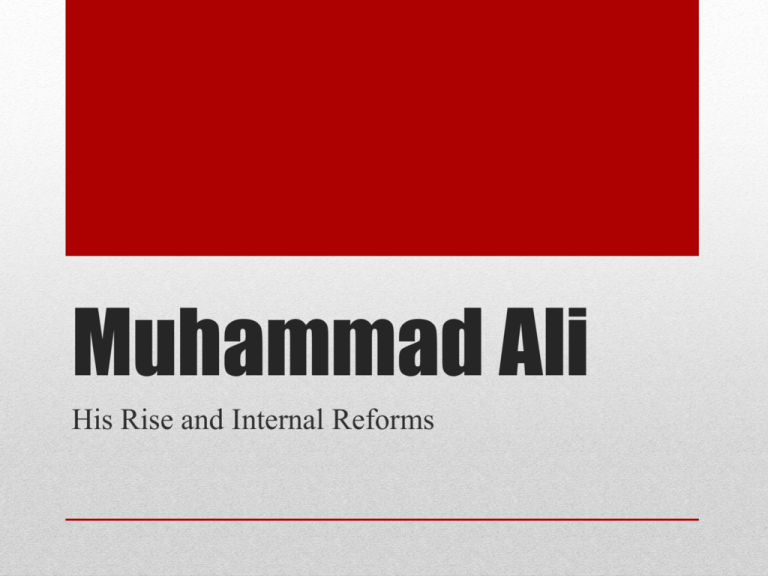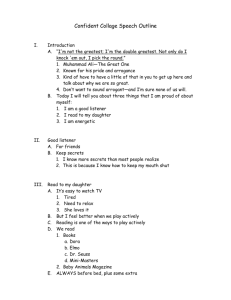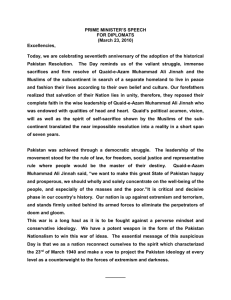Muhammad Ali - Annapolis High School
advertisement

Muhammad Ali His Rise and Internal Reforms • Assess the impact of Muhammed Ali on Egypt in the first half of the nineteenth century. Essential Question Mamluks and Egypt before Muhammad Ali • Ottomans control Egypt • Ottomans use Mamluks as the local rulers to control Egypt • Mamluks are a social class that had risen to control • Political anarchy "We are all pillagers; you pillage, and [he] pillages, and I pillage too." (One Mamluk to another, Jabarti) • Economic activity • Egypt begins to export raw materials to/import finished products from Europe • Sufi ṭarīqas flourish • ‘Ulamā’ flourish • Mediate between rulers and people • Considerable land in awqāf Egypt before Muhammad Ali • Originally from Balkan Region – ethnically Albanian, born in Kavala – Near Greece • Was promoted to military after serving as tax collector • Served as Second Commander of the Kavala Regiment of the Ottoman Empire under his Cousin. His Background and Rise • French invade Egypt in 1798 • Napoleon lands troops in Alexandria • Begins a war against the Mamluks • Disrupts balance of power in Egypt • Ottomans land on Nile Delta in 1801 to repel the French Reasons for Muhammad in Egypt • Muhammad Ali worked with local tribes of Egyptians while campaigning against French • Napoleon left in 1801, French expelled by 1802 • Mamluks wounded by not vanquished • Power struggle existed between Mamluks, Ottomans, and Muhammad Ali’s Army Success in Egypt • Muhammad Ali allied with local leaders to gain support of the public • Albanians forced Ottoman governor out in 1803 • Islamic Scholars demanded the Ottoman government appoint Muhammad Ali the Pasha - 1805 • This began Muhammad Ali’s seizure of power in Egypt • Sultan Selim III was unable to oppose because of Muhammad Ali’s popular support Consolidation of Power • After a temporary alliance with Mamluks to get rid of Ottomans, • Ali was focused on removing the leaders of Mamluks, then their followers • Ali invited the leadership to a celebration of an Arabian invasion, which they accepted in 1811 • His troops assassinated all the leaders • After their demise, Muhammad Ali sent his troops through Egypt to quash the rest of the Mamluks End of the Mamluks Assassination of the Mamluks • Muhammad Ali recognized the demise of the Ottomans: • “I am well aware that the (Ottoman) Empire is heading by the day toward destruction…On its ruins I will build a vast kingdom… up to the Euphrates and the Tigris’’ • Ali’s conquest of Mamluks and exile of former allies gave him total control over reforming Egypt • Prevented British invasion in _______________________________ • Establish a European style country be reforming all aspects of society: • ______________________________________________________ Ali’s Goals and Reforms • Institutes high taxes on land owning elite • Failure to pay would result in state control of farms • ____________________________________ • 1813: sharing of common land (changed the state of the fellaheen in Egypt) • Muhammad Ali established a virtual monopoly on land • ___________________________________ • Took control of new product – bought from producers • Sold to European to manufacture - Bought back from Europeans • Sold to public • ________________________________________________, which resulted in greater support of Muhammad Ali Gaining Control and Agricultural Control • Educational system was founded in 1821 – SEPARATE FROM RELIGIOUS EDUCATION • Offered scholarships for students to go _________________________ • Used to create people he needed for military (Veterinarians, doctors, engineers) • Established Language schools ___________________________________ • Focused on Tertiary education first • Ulema (Islamic Scholars) not prepared for “Western” subjects – math, science, language • To build a native Egyptian workforce and military, needed to educate the secondary and primary students • Took effort to educate all people in his country, especially girls • Established many schools particularly in rural areas Education Reforms • Muhammad Ali was the viceroy/ pasha of Egypt from 18051848 • He wanted to create an independent, sovereign Egypt politically and economically • Divided Egypt into 10 provinces and collected taxes from them Politics • Muhammad Ali desired a professional bureaucracy • He reorganized the administrative structure of the government • Created a professional governmental organization • Appointed sons to positions of power • Worked to modernize Egypt Political Reforms • Religious leaders acted as intermediaries/ buffers between the public and administration • Intermediaries would take money or authority for services • In times of crisis, intermediaries would usurp the central government • Guilds had tax-collecting elders • Village shaikh was power booker, money lender, and landlord Social Structure • Confiscated _______________________________ • 1808, he started confiscating private lands of individuals and gave them pensions • Landholders now collecting from _________________________ • Reform programs were aimed at creating a modern Egyptian society • European educations created social mobility for Egyptians • Primary recipients were __________________________________ Social Reforms • By reorganizing the administrative structure of the government, Muhammad Ali guaranteed strict control of the economy • Created state monopolies over chief products - 1809 • ____________________________ • Encouraged overland transit of goods ________________________________________________ • Early 1820’s – this practice resumed Economic Reforms • He tried constructing a modern industrial system to process raw materials • 1809 – _______________________________ • Shipbuilding and construction in ___________________ in 1809 • 1815 - Factories weaving silk and cotton • __________________________ used to manage factories • Foreign infrastructure (machines) imported to promote industrialization • Created factories to manufacture military goods • 1815 - _________________________________ begin production in Cairo Industrial Reforms • Monopolized all industry • • • • Forced __________________________ on foreign imports Merchants worked for government or went broke _____________________ trained to work in factories 1825 – Total exports valued at ~$10.6 million • Imports only ~$5 million • 1819 Started building a new canal, called Mahmudiya • This made travel safer and trading more efficient • Between _______________________________ • Named after Sultan Mahmut II Industrial Reforms Cont’d • Military campaigns forced need for more troops • Needed troops loyal only to Muhammad Ali and his sons • 1820 – _____________ – Peasants mandated to unpaid work and military conscription • Used to complete canals, provide troops for Sudan and Greece • _____________________specifically during late 1820’s following losses in Greece • French were used to train and modernize Egyptian Army • Also assisting in modernization of industry • Military leaders training in Europe since _________________ Military Reforms • Establishment of Training grounds throughout Egypt following Arabian Campaign • ________________________________ led Aswan camp • Patterned after French Army • Bought and built artillery • Built ________________________________ schools to train troops • 1826 - ______________________________to train military and government officials • French regulations translated into _______________ Military Reforms • Muhammad Ali was unable to sever ties with Ottoman Sultanate • ________________________________________due to Egypt’s lack of power sources and a skilled working class • Agricultural sector declined due to _____________________________ and ____________________ • _____________________________increased because of military campaigns Failure of Reforms ESTABLISHING CONTROL OVER MIDDLE EAST AND AFRICA • _______________________in 1808 – Muhammad Ali fends them off • ________________________to prevent the Wahhabi Rebellion – 1811 • • • • Celebration was the end of Mamluk Leaders in Egypt Tusun, at the time eldest son of Muhammad Ali, led the invasion. Controlled _______________________________ By 1813, was planning to take Diriyah – the capital of the Wahhabi rebellion - 1815 – a treaty is signed with Ibn Saud’s son Abdullah I • 1816 – Muhammad Ali ____________________________to finish the campaign • Long and arduous marches – Diriyah Captured by 1818 • Muhammad Ali controlled ________________________, and had designs to complete his empire. Muhammad Ali Controls the Middle East • 1820 – Muhammad Ali decides to conquer __________________ • February 1820 – captured Siwa in the _______________________ • July 1820 – Ismail (youngest son) leads troops south • • • • • Ismail meets with quick progress Muhammad Ali also dispatches _________________________ ____________________________ by a Sudanese King in 1822 Mohammad Bey leads the rest the expedition By 1825, Controls most of ______________________and _____________ through the Sudan down to Massawa on the Red Sea Muhammad Ali Controls Libya and Sudan EGYPTIAN EXPEDITION IN GREECE • Greek Rebellion – Asked by Sultan in intervene • ___________________________ by 1824 • ___________________________(already controls the Hejaz) • In return for his participation in _________________________ • Invades Pelopon nesus in 1825 – controls ________________ • Battle of ________________- 1827 • Rejection of the Treaty of London led to Naval Battle • Muhammad Ali’s navy _____________________ • British ships appear off __________________ and “convince” Muhammad Ali to withdraw troops from Greece • French landed troops in 1828 – ______________________________ Muhammad Ali Sends his troops to Greece



